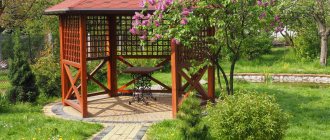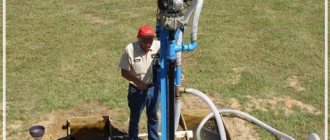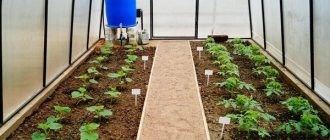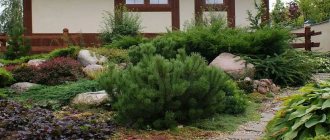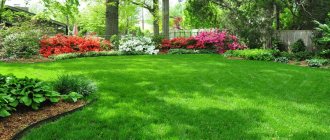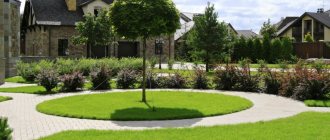Just recently, it would never have occurred to the owners of the coveted six acres to have a gentle and soft lawn on their property.
Everything not occupied by the vegetable garden and berry garden was planted with potatoes with tenacity worthy of better use. As a last resort, the aesthetic needs of the owners were satisfied with a small flower bed near the porch. Current landowners, who are not limited to six hundred square meters, quickly appreciated the beauty of open lawns, and lawns quickly gained popularity in Russia.
If you decide to join the army of fans of beautiful velvet grass and set yourself the task of creating a real lawn, making it the basis of the landscape of your site for many years, first of all think about choosing seeding material. It is no secret that most cheap mixtures consist of either slightly cultivated or simply forage grasses. It is clear that they are completely unsuitable for a high-quality ground lawn, and even more so for a golf lawn. To get a good lawn, you need special varieties of grass.
An ideal lawn, regardless of the specifics of its application and the mixtures included in it, should have a high turf density, have a beautiful rich dark green color and be as unpretentious as possible. The correct choice of lawn mixture guarantees excellent results, and modern selection allows you to find the best option.
What types of lawn grasses can you find today? Fast-growing and shade-tolerant, universal and for creating sports fields, flowers, parterres, for extreme urban conditions; There are even separate mixtures for landscaping slopes and roadsides. Seeds in a special shell are in great demand, which fundamentally changes the technology for creating a silk lawn. The composition that envelops each seed allows you to get by with a minimum of fertilizers. It already contains the basic microelements necessary for friendly shoots and rapid growth of young lawn grass. This significantly reduces the cost of time and money, and the birds become completely indifferent to such seeds, without pecking them when sowing.
And three more things are important for the successful implementation of the plan - thorough tillage of the soil before sowing, timely watering and cutting of grown grass. The result is a magnificent green space that you can be proud of and will certainly become the envy and admiration of all your friends and neighbors.
What are the characteristic features of different types of lawns, the characteristics of their cultivation and the biological requirements of plants?
Main types of lawns
The ground lawn is a beautiful decorative lawn of emerald green grass. It consists mainly of a mixture of narrow-leaved grasses; individual types can be used. We recommend sowing bentgrass, which has a valuable biological feature - aggressiveness, since its stems (stolons) are able to quickly grow and restore bald spots that appear on the lawn. Seed consumption - 1.5 g per 1 square. m. Mow bentgrass less often than usual - once or twice a month. The seeds should only be sown in weed-free soil as it is a slow-growing grass. Do not sow bentgrass unless you can provide regular watering. The main part of the roots is located in the surface layer of soil - no deeper than 15 cm. This type of lawn is used in places not intended for walking and not subject to increased loads. The ground lawn does not forgive mistakes in care, and if you are not yet confident in your abilities as a gardener, it is better to focus on mixtures of ordinary lawn grass seeds.
Ordinary lawn . Don't be put off by such a prosaic name: in most cases this is exactly what you need. You can choose a trampling-resistant “Sports and Games” mixture made from special varieties of grasses that form a dense turf. It is perfect for a sports or children's playground, or for planting around a barbecue. Special mixtures have been created for shaded areas that perfectly tolerate partial shade (for example, “Shady Garden”). The Liliput mixture will reduce the number of lawn mowings by 2-3 times. If the area is varied or you don’t expect too much walking on the lawn, choose the “Universal” mixture.
Clover lawn is created from creeping clover. An ideal lawn for lazy people or those who don't have time to mow it every week. It does not require special equipment - a trimmer or, at worst, a scythe is enough to mow the clover once a year, after flowering. It is resistant to trampling, easily tolerates lack of moisture, and grows even on acidic soils. Flowers attract bees and other beneficial insects to the site. By the way, beautiful aromatic and pleasant-tasting honey is obtained from clover trees. The soil for clover is prepared as for a regular grass lawn. The seeding rate is 1.5-3 g of seeds per 1 sq. m. Clover is an aggressive crop; do not allow it to occupy other areas, dooming yourself to many years of struggle with the weed. Mow clover heads before seeds form.
The perennial Moorish lawn (meadow lawn) consists of grasses and 10-20 species of annual and perennial, usually low-growing flowering plants. Usually sown in small areas in the far corners of the garden. The Moorish lawn is as close as possible to natural plant communities. It is very difficult to maintain its fragile ecological balance. A properly selected Moorish lawn blooms with all the colors of summer from June until the first frost. The aromas of meadow herbs are no worse than luxurious roses and gillyflowers. In addition, such plantings attract a lot of beneficial insects, birds, and lizards.
The annual Moorish lawn consists of 20-30 types of flowers.
Weeding at seedlings is impossible, so before sowing it is necessary to especially carefully prepare the soil, ridding it of the rhizomes of perennial weeds. Choose a place that is sunny and open. It blooms later than the previous species, but surpasses it in showiness and colors. Drought-resistant, requires virtually no maintenance. Mow the lawn after the plants have flowered and fertilized. Next year, the species composition, unfortunately, may decline: the most viable species survive.
Setting up a sowing lawn
A lawn at the dacha will improve the area and make it pleasant to be on the site. In addition, according to scientists, contemplation and being among the color green promotes health. Before you go shopping for everything you need to arrange your lawn, also decide on the issue of designing its edges. This can be done using lawn stone, which comes in various types.
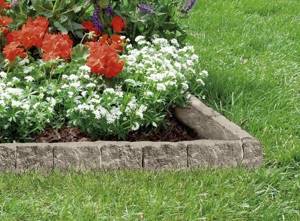
The process of arranging a lawn consists of several stages. Before sowing a lawn, the first step is to prepare the area chosen for it. It needs to be cleared of debris and plants. This can be done by digging up the soil, or by using special chemicals. But remember that there should be no pets or children nearby at this time. First, let's clear the area of debris and remove particularly large weeds from it. The classic method is environmentally friendly, but time consuming and requires considerable effort and pedantry.
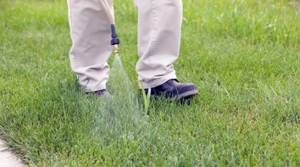
But with chemical processing, you practically don’t have to do anything. The next step is to lay the area with one of the rolled materials. It is better, of course, to purchase special materials for waterproofing for this, but, as a last resort, you can use roofing felt. How to properly sow a lawn on a personal plot? In principle, it's simple.
In the case of a rolled lawn, everything is simpler. Lawn mesh is laid in spring, summer or autumn. The roll is simply rolled out and leveled. If the lawn is seeded, then it is better to arrange it in the spring. Many people prefer to sow lawn grass in the spring to enjoy a pleasant carpet of greenery in the summer.

Before planting the seeds, loosen and level the soil. Seeds for the lawn are not sown in furrows as in garden beds; they are evenly scattered over the entire area of the lawn. The seeds are sown as evenly as possible, while the edge of the lawn should have a high concentration of them. This problem can be easily solved with the help of a seeder, designed specifically for these purposes.
How to properly place seeds in the soil over such a large area so that they sprout together without being blown away by the wind or washed away after the rain? Deepening is done with rakes or flat cutters. It is also advisable to lightly press down the seeds. All these measures will ensure good contact of seeds with the soil and increase their germination due to closer contact with the soil.
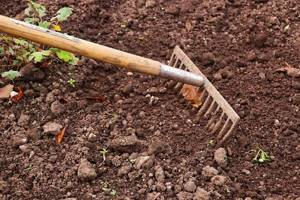
The seeds are pressed down with a special garden tool called a “roller”. If this is not available, you can use a metal pipe or a rake. Planted seeds require irrigation by sprinkling, so as not to wash away the planted seeds from the soil. Finishing the edges of the lawn with something or leaving it as is is a matter of taste. Both options look good.

You can erect a border for the lawn, this will give it a well-groomed and compositionally complete look. But you don’t have to do this, since the lawn itself is completely self-sufficient. Arranging a lawn is not such a difficult task if you first prepare for it theoretically, because knowledge of the nuances is also important.
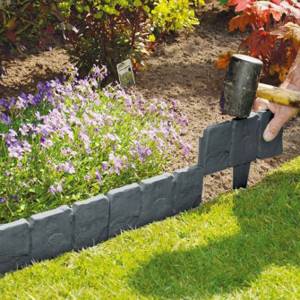
Seeds and grass mixtures
Among the plants for a non-grass lawn, especially on poor sandy or rocky soils, the still rare horned frog, a perennial leguminous plant, has proven itself well. It blooms annually from May to July - a period when the shortage of flowering plants is most acute. Lyadvenets forms a beautiful golden-yellow carpet. Grows well when mowed. Tolerates trampling. Plants reach a length of 35 cm, but the height of the lawn is no more than 20 cm, since the frog creeps along the ground. Undemanding to soil, grows well on sandy and rocky soils. Drought resistant. As befits any self-respecting legume plant, it enriches the soil with nitrogen. If its color or flowering time do not suit you, sow phacelia - an ascetic plant, generously ready to forgive the owner both poor soil and lack of watering. It blooms for 45–60 days in July–August, forming a purple-blue carpet. One of the best herbaceous honey plants. It is sown in spring at the rate of 2 g of seeds per 1 square meter. m.
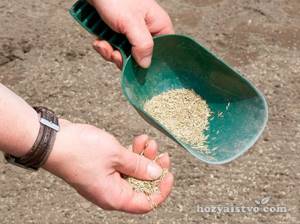
We recommend experimenting with ground cover plants, setting aside a small area for this. You don't need a lawnmower. You can use various types of sedums, speedwells, bird knotweed, noble navel, creeping varieties of yarrow. If you couldn’t buy seeds of these species, no problem, buy them at a nursery or find a couple of plants in nature, and in a month or two you can easily grow the required amount by cuttings. Plant in a permanent place at intervals of 20 cm. In one to two months they will close together into a solid carpet.
In the southern regions of Russia, thyme (thyme) is excellent. Thyme has small, fragrant leaves, plant heights range from 5 to 15 cm. Its flowers are tiny and colorful.
The lawn is usually the center of the garden, the canvas on which the main pattern is drawn. Without maintenance, an abandoned grass lawn can turn into a wasteland in a few months.
Calculation of seed consumption for sowing a lawn
It can be quite difficult to calculate the consumption of seed material; in many grass mixtures, large and small seeds are mixed together and the seeding rate of lawn grass depends on the totality of their characteristics.
In this case, it is recommended to use the following formula:
N=n*p/D
Where the values are equal:
- N is the optimal sowing rate of grass mixture seeds;
- n is the sowing rate of a certain type of seed (kg/ha);
- p is the percentage of participation of this species in the grass mixture in its pure form (%);
- D - actual seed germination %.
Using this formula, you can calculate the approximate value of the seeding rate; in practice, this value can be 2-3 times higher.
Table of germination of seeds of different herbs:
| Plant name | Minimum n/v (g/m2) | Optimal n/v (g/m2) |
| Meadow bluegrass | 4-5 | 10-15 |
| Red fescue | 15 | 30-40 |
| Thin bentgrass | 2-3 | 5-10 |
| Swamp bluegrass | 2-3 | 5-10 |
| Oak grove bluegrass | 5-8 | 15-20 |
| Common bluegrass | 4-5 | 10-15 |
| Bluegrass oblate | 4-5 | 10-15 |
| Poa angustifolia | 4-5 | 10-15 |
| Meadow fescue | 18-20 | 40-50 |
| White bentgrass | 3-4 | 8-12 |
| Bentgrass | 2-3 | 10-15 |
| Dog bentgrass | 2-3 | 10-15 |
| Raigas perennial | 15-20 | 30-50 |
First watering of lawn grass
Shoots begin to appear on average after a week or three. Watering during this period is necessary every few days (if there is no rain). Watering must be done carefully - a watering can with a fine sprinkler or a sprinkler that sprays thin streams of water are suitable. When the lawn becomes large, the grass will reach ten centimeters in height. At this time, you can carry out the first haircut.
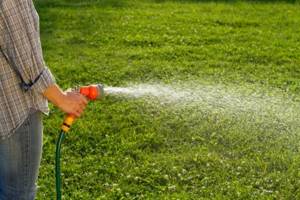
Strong water pressure should be avoided when watering, in order to avoid washing out the soil layer, ungerminated seeds, and sprouts that have appeared. Knowing all the intricacies of lawn care, you can create an impeccable lawn, the appearance of which will delight you all season, and this will require a minimum amount of effort.
Soil preparation
The area for the lawn is being prepared for many years to come; it will have to provide the plants with everything necessary for full growth and development. We begin preparations in advance. It takes about three months from the start of work to sowing the seeds. The site should be cleaned, all necessary components should be added, leveling should be carried out, and the soil should be treated once or twice with continuous action herbicides (depending on the weediness of the site). Then the soil should settle.
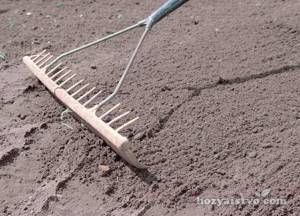
We begin work with clearing - uprooting stumps, removing stones and construction debris. Do not bury garbage on the site; in the future, in the places of such “burial grounds” the plants will differ in color and appearance.
If the soil is waterlogged, drain it. Loamy and clayey soils require the mandatory application of sand (preferably coarse river sand) at the rate of 10 kg per 1 sq. m. m. On sandy and sandy loam soils, add peat or rotted compost. Fresh manure is not recommended. In the Central and Northwestern regions of Russia, the soil is often acidified (the optimal pH value is 5.5-6.8). If you do not have the opportunity to conduct an agrochemical analysis, focus on biological indicators of soil acidity: horse sorrel, horsetail, and moss growing on the site indicate the need to deoxidize the soil with slaked lime, chalk or dolomite flour at the rate of 50 kg per hundred square meters.
The fertile soil layer must be at least 25 cm, otherwise you will have to add soil.
Before digging the soil, apply a complete mineral fertilizer (nitroammofoska, lawn kemira or any other) - 50 g per 1 sq. m. m. Three to four weeks after digging, we treat the rapidly developing weeds with continuous action herbicides (Roundup). The main problem of a newly created lawn is perennial rhizomatous weeds (dandelion, thistle, wheatgrass, horsetail, etc.), which literally break through the emerging turf of the lawn. Chemical treatment is often the only way to get rid of them. In a heavily weeded area, it is better to re-treat the herbicide after two to three weeks. When processing, protect cultivated plants located here or nearby with plastic film.
The next stage is soil leveling. Small areas are leveled by dragging a small ladder or a 2-3 meter board several times in perpendicular directions. The remaining depressions can lead to the lawn getting wet and damp in the future. Be sure to thoroughly compact the soil, this will ensure more even settlement and the absence of hummocks and holes.
Moorish lawn
An elegant and unusual lawn in the Moorish style is based on beautiful flowering plants. The lovely lawn includes more than ten varieties of grass.
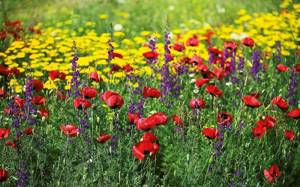
The most commonly used flowers here are daisies, cornflowers, poppies, flax, nasturtiums, gypsophila, marigolds, and bluegrass. You can create a mixture of herbs and flowers yourself, selecting them in such a way that they bloom all season and do not interfere with each other, or you can buy a ready-made collection.
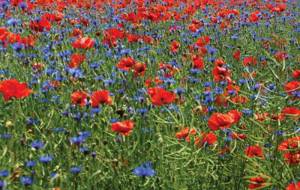
A properly selected Moorish lawn can bloom in a very short period of time, so very soon after planting, the owners will be able to enjoy a riot of colors and delicate greenery.
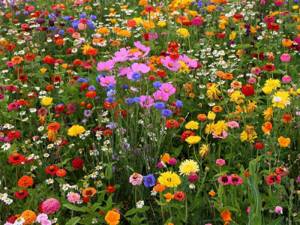
Such a lawn does not need regular mowing, but loves water and sunlight. The advantage of such a lawn will be the ability to create small lawns. The Moorish lawn does not need a large length at all.
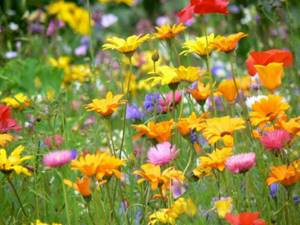
Walking on it or playing fun games on it is not recommended.
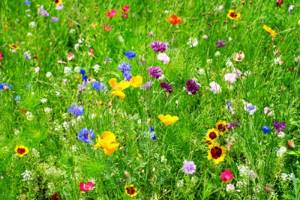
How to sow correctly
You have completed the most labor-intensive stage - preparing the soil for sowing. The next step, sowing seeds, cannot be sloppy or hasty.
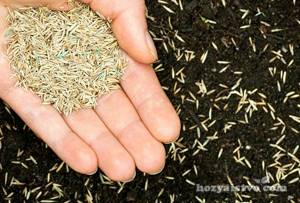
Grass seeds must have normal germination and germination energy. For the Central and Northwestern regions, a germination rate of at least 80-90% is required. According to Russian standards, seeds must correspond to class 1, i.e. have no more than 1% weed admixture. Unfortunately, it is not yet possible to completely free lawn grass seeds from weeds, but it will not be superfluous to make sure that the seller has a quality certificate.
The mixture or type of lawn grass used must match your climate zone, soil type, and light level of the area.
Follow the seed sowing rate indicated on the packaging. By lowering it, you doom yourself to a constant war with weeds, which will not miss their chance in the fight for a place in the sun. On the other hand, do not act on the principle “you can’t spoil the porridge with oil” - overestimating the seeding rate can later lead to damping out of the lawn.
Be sure to save 10-20% of the seeds for possible restoration of the lawn in the future (your four-legged friend is too actively enjoying life on the still fragile lawn, but you never know...), since each mixture has its own shade of green. Lawn grass seeds remain viable for three to four years, so it is better to insure your lawn against the possible vicissitudes of life.
You can sow lawn grasses from the end of April until the second ten days of August.
Summer July sowing is only allowed if you are able to provide constant watering. The soil is thoroughly watered one or two days before sowing. The best conditions for sowing seeds are when the soil is slightly dry on the surface and does not stick to the base. Sow in calm, windless weather. Shake the seed packet thoroughly. It is better to mix them with sand in a 1:1 ratio. Sand marker (it is clearly visible on dark soil) allows you to achieve uniform sowing. The seeds are divided in half, half are sown along the plot, and the other half is sown across. To move around the site, so as not to disturb its layout, use a wide board or sheet of plywood. After sowing, lightly cover the seeds with a fan rake and roll again. Do not try to embed them completely into the soil, otherwise uneven sowing will not be avoided.
After a couple of days, water the lawn using a fine mist of water to prevent the seeds from being washed away. Stagnant water can also disrupt the uniformity of sowing.
Birds pose a serious danger to newly sown lawns. It is better to stretch a special mesh or black threads from them crosswise at meter intervals at a height of 5-10 cm. In the first stages, sowing is especially sensitive to lack of moisture. There is no rain for several days - be sure to water with a sprinkler or watering can with a fine spray of water that does not allow the seedlings to be washed out.
Lawn drainage
If the area under the lawn is not flooded by rain and groundwater, then there is no need to do drainage. In this case, the soil is simply dug up and limed. You can also add fertilizer. In most cases, drainage is necessary. The construction of the drainage system is carried out after leveling the territory.
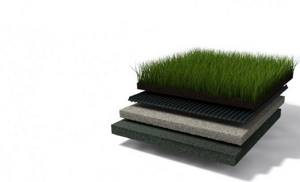
Lawn drainage diagram
Proper arrangement of rolled lawn grass requires a strictly defined organization of drainage. To do this, a layer of soil of a certain depth is removed, and sand and crushed stone are laid in layers in this hole. The height of each layer should not be less than ten centimeters. After backfilling, they need to be compacted properly. An alternative to sand is geotextiles.
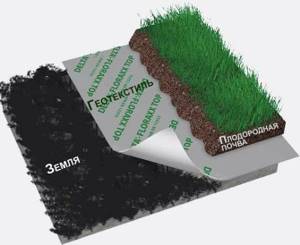
The removed layer of fertile soil is then poured on top of the sand-crushed stone sandwich. In complicated cases, three drainage layers are made (large crushed stone, sand, small crushed stone). Which scheme is best suited for your site? It turns out simply. It is necessary to take into account the size of the territory, the location of groundwater, and the type of soil.
How to properly care
In the first year after planting
Seedlings usually appear one to three weeks after sowing, depending on the type of lawn and air temperature. Bluegrass, bentgrass, and clover grow the slowest, and accordingly they place higher demands on cleaning the soil from fast-growing weeds, since they simply may not be able to withstand competition with them.
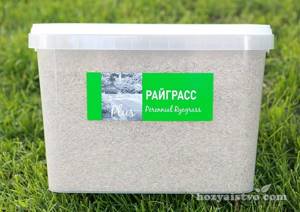
In a mixture of lawn grasses, perennial ryegrass is an essential component. It quickly occupies the territory, and then, under its protection, other more valuable narrow-leaved grasses develop - fescue, bluegrass. If necessary, water the lawn carefully, preferably in the evening to avoid sunburn of the leaves. Remove weeds with a sharp knife. The first cutting is carried out when the plants are about 15 cm long at a height of 10 cm. The height of subsequent cuttings is reduced, bringing them to 5 cm after one or two months. Do not allow the lawn to overgrow, since plants painfully tolerate a loss of more than 2/3 of the height. Additionally, delays in mowing can result in pale green patches appearing on your lawn. Use lawn mowers with sharp blades and a grass catcher, or carefully collect the clippings with a fan rake. Left under the mown grass, the plants can rot. The mowing height depends on the type of lawn (for example, a parterre lawn is mowed to a height of 3 cm, a regular lawn is cut to a height of 5 cm) and seasonal conditions (in dry periods, we recommend increasing the mowing height by 2 cm).
If you mow a lawn higher than 7-8 cm, there is another danger - less valuable broad-leaved grasses will be replaced by narrow-leaved grasses, which, in fact, ensure the quality and aesthetics of the lawn. It is better to mow the lawn a day or two after watering.
When watering, the soil should be wet to a depth of 15-30 cm. Frequent and weak watering leads to superficial development of roots. There are no clear watering rules. Plants signal moisture deficiency by loss of elasticity and wilting. Water the lawn when the surface layer dries up to 10 cm, in dry weather - once a week. The main thing is that the soil has time to dry out between waterings and the root system of the plants receives enough air. Excessive watering can lead to the appearance of moss on the lawn, while insufficient watering can lead to the crowding out of lawn grasses by drought-resistant weeds. In the first year, if you have prepared the soil well, it is better not to feed the plants or subject them to excessive stress (even if you sowed a mixture of lawn grasses for sports and games). Before going into winter, in order to avoid winter damping off of plants, the lawn must be mowed, but so that the grass grows at least 10 cm high before winter.
When is the best time to sow a lawn at your dacha?
The owner of a personal plot who has decided to improve the area with a lawn is, of course, interested in when is the best time to sow lawn grass. “Sowing” can be carried out over a long period. There are no exact dates for sowing lawn grass; it is better, of course, to sow in the spring, but you can sow from the beginning of April to the end of October (depending on the region). The main thing is that the weather is dry and warm at this time. But at the same time, the seeds need to be watered by spraying so that they are not washed out of the soil and remain slightly moist for a long time.
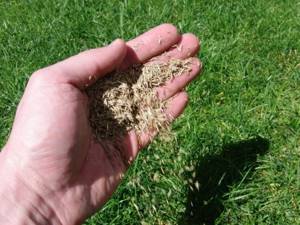
Before sowing lawn grass on your property, check the weather forecast for the near future. The sown seeds are moistened until the lawn grass reaches a height of six centimeters, since they do not germinate at the same time. A finely dispersed supply of water for irrigation must be maintained later, so as not to damage the tender shoots. In order for the seeds to germinate soon after sowing, a certain soil temperature is required. If it is not warmed up sufficiently, germination may take a long time.
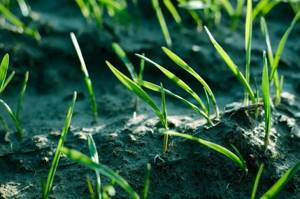
There are three opinions on when to sow lawn grass correctly. Some consider September a favorable time, others - May, and still others - all three months of summer. The first argue their point of view by saying that summer is sometimes so hot that the seeds will simply burn in the hot soil; at the beginning of autumn, the ground is warm and moist, and these are the conditions that are most suitable for sowing lawn grass.
Do it yourself - How to do it yourself
In a pleasant garden, there is always a lawn, which improves the microclimate of the area, serves as an excellent frame for the mixborder, effectively contrasts with bright flowers, and elegantly combines with the greenery of coniferous plants.
A rectangular lawn looks interesting and logical in a small garden, but a round one is especially good for a small plot; this shape will hide the corners of the plot with the help of plants planted there and visually expand the space. It is generally accepted that the minimum diameter of a round lawn is 3 m.
Whether we realize it or not, our eye identifies round and spherical shapes in the garden, the repetition of such elements allows us to make any design STYLISH AND CALM.
This summer I admired the wonderful round lawn in the St. Petersburg garden of Yuri Borisovich Markovsky. This man has long been known to all lovers of ornamental gardening; many years ago we watched programs with his participation on Leningrad television and videotapes (now a forgotten medium of information), in which he taught us how to properly prune jasmine and propagate perennials, prepare the soil for creating a lawn and lay stones. He is the author of a large number of gardening books, a man with impeccable taste and vast practical experience in gardening. His own garden only confirms his impeccable reputation!
EVERYTHING YOU NEED FOR THIS ARTICLE IS HERE >>>
The photo shows a clear border of a round lawn framed by a tiled path. It is very important! If the garden is designed using geometric lines and shapes, they must be clearly legible not only on the plan, but also when taking it out into nature, everything must be verified down to the centimeter, even a slight negligence in this case spoils the matter. Around the lawn there is a wide mixborder, along the front edge of which many plants are planted, including variegated hostas, spherical thujas, ferns, and geraniums. There is also a beautiful wrought-iron bench there, on which guests love to take pictures. The diameter of the lawn is about Yum.
Circular layouts are also successfully used in gardens near Moscow.
In front of you is the garden of Nadezhda and Mikhail Ignatiev in Zhavoronki. There are only 6 acres here, but the garden is designed so competently and intelligently that it seems that it is much larger. There is no fuss and inconvenience, unfortunately, characteristic of many thoughtlessly planned 6-acre properties. The diameter of this lawn is 7.4 m.
Pay attention to the clearly defined boundary between it and the gravel, this is fundamentally important. What plants frame the round lawn in this garden?
These are not only coniferous and deciduous shrubs, but also daylilies, bergenia, hostas, buzulniki, even cereals (pike).
In principle, you can use any plants of the color scheme you choose, for which the lighting, humidity and soil characteristics of the given place are suitable; round-shaped plants are especially welcome, they will emphasize the round shape of the lawn.
Is it possible to plant something on a round lawn or is it better to avoid it? In Markovsky’s garden, the lawn is completely free of plants, and rightly so. A daylily is planted in the Ignatiev garden.
I think it’s better not to plant anything at all; as a last resort, if you really want to or have nowhere else to arrange it, plant one plant that will not interfere with the readability of the geometric shape. And in no case should you make numerous plantings on such a lawn, this completely destroys the whole idea.

